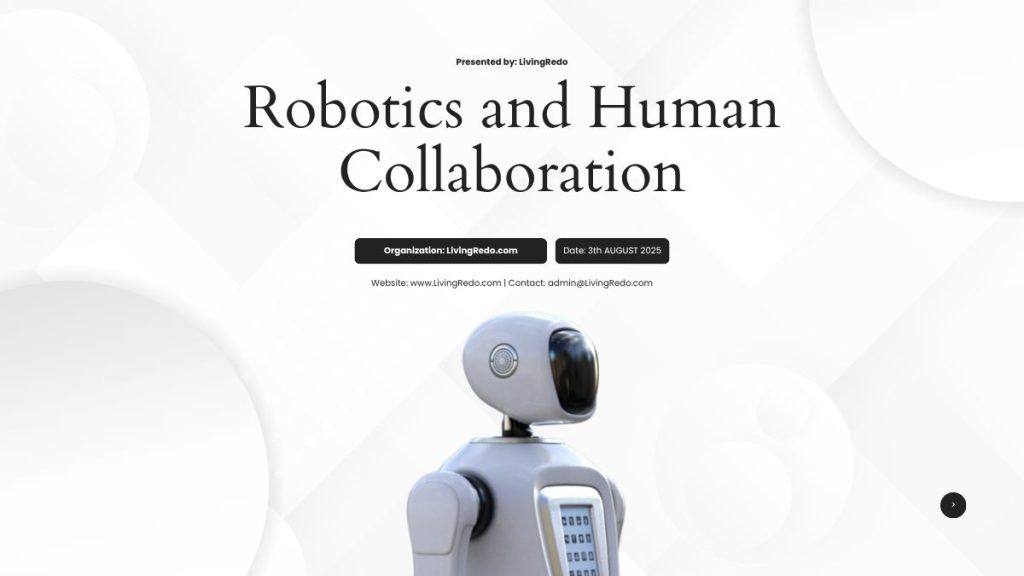Introduction: The Age of Machines and Minds
As we step deeper into the age of intelligent automation, robotics and human collaboration have emerged as one of the most impactful themes in technology. Unlike traditional robotics, where machines operated independently of people, today’s innovations are designed for partnership—machines that not only work alongside humans but amplify their capabilities. This powerful fusion is reshaping everything from manufacturing and healthcare to disaster response and education.
This article explores the top 10 breakthroughs driving this human-robot synergy and how they’re revolutionizing modern life and work.
1. From Assistants to Teammates: Evolution of Collaborative Robots
The journey from industrial robots confined behind safety barriers to today’s collaborative robots (cobots) has been swift and remarkable. Cobots are designed to work directly with people in shared spaces. They adjust to human behavior, improve safety, and enhance productivity. Unlike traditional robots that required specialized programming, many cobots can now be “trained” through demonstration, making them more accessible across industries.
The most transformative aspect? Cobots don’t replace humans—they assist, guide, and learn from them.
2. AI-Powered Robotic Decision-Making
One major leap in robotics has been the infusion of artificial intelligence. Robots today can process real-time data, recognize speech, identify objects, and even make independent decisions.
For instance, autonomous mobile robots (AMRs) in warehouses can choose optimal paths, avoid obstacles, and adapt to dynamic environments. The ability to reason and respond makes these machines truly collaborative partners, capable of adjusting to human behavior on the fly.
3. Robots with Emotional Intelligence
Emotionally intelligent robots are no longer science fiction. Breakthroughs in affective computing now enable machines to interpret human emotion through facial expressions, voice tone, & gestures. These emotionally aware robots are especially useful in healthcare, elder care, and education.
A great example is the “Pepper” robot used in hospitals to offer companionship and comfort. By recognizing emotions, these robots can respond more empathetically, improving trust and cooperation between humans and machines.
4. Safe Physical Interaction in Workspaces
Safety is a core pillar in robotics and human collaboration. Advanced sensor systems and real-time feedback loops allow robots to detect human presence, pressure, or motion—instantly halting operations when necessary.
For example, companies like Universal Robots have developed cobots that sense human touch and reduce speed when a person is nearby. These features ensure not only physical safety but also foster psychological comfort, encouraging people to embrace robotic teammates rather than fear them.
5. Robotics and Human Collaboration in Manufacturing
The manufacturing sector leads the charge in collaborative robotics. Factories now feature robotic arms working side by side with humans to assemble electronics, vehicles, and even delicate items like medical devices.
This synergy reduces fatigue-related errors, increases production speed, and ensures consistent quality. Humans provide creativity and problem-solving; robots bring precision and endurance. This balanced division of labor enhances both operational efficiency and employee satisfaction.
6. Healthcare Revolution with Surgical Cobots
Perhaps nowhere is the impact of robotics and human collaboration more profound than in healthcare. Surgical robots, like the da Vinci system, don’t replace surgeons but extend their capabilities with microscopic precision and 3D visualization.
Nurses and doctors collaborate with robotic tools for minimally invasive surgeries, leading to quicker recovery time, fewer complications, and improved outcomes. In rehabilitation, robotic exoskeletons help patients regain mobility while therapists monitor progress in real time.
7. Human-Robot Teams in Disaster Response
Disaster response is a high-risk field where human-robot collaboration can be life-saving. Drones & grounds robots equipped with sensors and cameras help locate survivors, assess hazards, and deliver supplies in inaccessible areas.
Robots like Boston Dynamics’ “Spot” have been used in search-and-rescue missions, navigating treacherous terrain where it would be too dangerous for humans. The human-robot team—where one guides while the other explores—enables faster, safer operations.
8. Smart Warehousing with Autonomous Robots
E-commerce and logistics giants like Amazon and Alibaba deploy thousands of collaborative robots to streamline warehouse operations. These robots transport goods, optimize inventory, and coordinate with human workers in real time.
What makes this setup revolutionary is the AI-based collaboration network, where robots “talk” to each other and human supervisors. The result? Faster deliveries, reduced workload for staff, and more innovative use of space and resources.
9. Education and Training with Collaborative Robotics
Educational robots are increasingly being used to teach programming, engineering, and even emotional skills. Students interact with these robots in collaborative projects, enhancing engagement and learning retention.
For adult training, virtual reality combined with robotic simulations allows workers to practice technical skills without real-world consequences. This blend of immersive tech and robotics makes learning safer, faster, and more adaptable to various industries.
10. The Future of Work: Coexisting with Intelligent Machines
Looking forward, the workplace will not be manned by robots or humans—but by both. Instead of replacing jobs, collaborative robots are evolving roles, requiring humans to supervise, customize, and creatively enhance robotic systems.
Companies investing in training programs that prepare employees for robot interaction are seeing higher retention and productivity. Rather than a threat, robots are being recognized as essential collaborators that help humans focus on higher-value tasks.
Frequently Asked Questions (FAQs)
Conclusion: Embracing the Robotic-Human Future
The top 10 breakthroughs in this article clearly show that robotics and human collaboration aren’t just a buzzword—it’s a pivotal shift in how we live and work. From hospitals to factories and classrooms to disaster zones, this alliance is improving safety, efficiency, and innovation.
As the tech continues to evolve, the key will lie not in choosing between humans or robots, but in optimizing the strengths of both—side by side.
